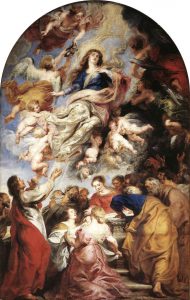WelCom August 2018:
The Church describes Sunday as the ‘foremost holy day of obligation’ (Catechism of the Catholic Church, n 2177). Other ‘holy days of obligation’ have always been added to the Sundays. In New Zealand, we now have only two of these additional holy days of obligation – Christmas Day and the feast of the Assumption, August 15. The feast of the Assumption of the Blessed Virgin Mary, also known as Assumption Day, marks the day God assumed Mary into heaven following her death. Mary’s assumption into heaven is also the patronal feast of the Catholic people in New Zealand.
Shh… it’s time to whisper
Dr Elizabeth Julian rsm

Assumption of the Virgin Mary – De hemelvaart van Maria, Rubens, c 1626.
It was 14 August 1958. The little packet of pink smokos [lollies], bought at the shop in Convent Rd next to the school, inexplicably developed a hole while in the pocket of my black gym-frock [school uniform]. It’s a long way from Ōtaki to Manakau on the bus when you’re six and the temptation for my little hand was just too great to resist. By the time I got home only two smokos remained. My mother needed no explanation about the planned present for her birthday the next day. She knew the truth and she ‘took me into her arms without judging me’.
That same date marks the patronal feast of our country – Mary’s assumption into heaven. The actual dogma says:
We pronounce, declare, and define it to be a divinely revealed dogma that the Immaculate Mother of God, the ever-Virgin Mary, having completed the course of her earthly life, was assumed body and soul into heavenly glory.
The feast affirms the very goodness of our bodies – the whole person will be saved. Mary has been totally redeemed and now shares fully in the risen life of her son Jesus. She is not a ghost or a spirit floating around in the sky. She is a real bodily person. What happened to her will ultimately happen to us. As we pray in the Creed: ‘We believe in the resurrection of the body and life everlasting.’
At the end of his recent Exhortation on holiness, Gaudete et Exsultate, Pope Francis writes:
I would like these reflections to be crowned by Mary, because she lived the Beatitudes of Jesus as none other. She is that woman who rejoiced in the presence of God, who treasured everything in her heart, and who let herself be pierced by the sword. Mary is the saint among the saints, blessed above all others. She teaches us the way of holiness and she walks ever at our side. She does not let us remain fallen and at times she takes us into her arms without judging us. (#176)
This is the Mary we honour today, teaching ‘us the way of holiness’ and walking ‘ever at our side.’
The gospel reading for the Assumption is Luke’s story of Elizabeth’s visit to Mary and the latter’s great song of praise, the Magnificat (Luke1: 39-56).) Its two parts are about love of God and love of neighbour, or spirituality and social justice, or contemplation and action. Whatever approach we take we immediately get caught up in Mary’s cry of joy. Mary the poor, struggling Galilean peasant woman, has been chosen by God.
In the second part, Mary sings passionately of God’s mercy to oppressed people, God’s victory over the powerful. First century Palestinian Jewish society called out for this kind of salvation. The song is full of powerful verbs. The coming of God’s reign will mean much reversal: the hungry will be fed, the lowly exalted and the powerful toppled. Mary herself, the teenager pregnant with the Messiah, embodies the reversal she proclaims.
My mother did not need me to tell her what I had done. She knew. Mothers just know. Pope Francis urges us to remember this:
Our converse with her consoles, frees and sanctifies us. Mary our Mother does not need a flood of words. She does not need us to tell her what is happening in our lives. All we need do is whisper, time and time again: “Hail Mary…” (#176).
So, let’s all whisper on this great feast.